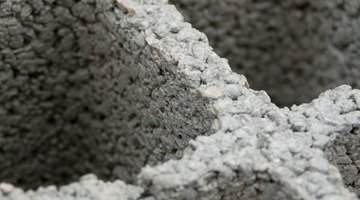Driveways Made of Cinder Blocks
A green driveway is one that’s sturdy enough to carry the weight of vehicles yet also creates space to grow turf grass – becoming literally green.

Cinder blocks and other types of concrete pavers make it possible to build a driveway that is completely permeable, allowing water to percolate naturally into the ground rather than add to polluted surface runoff. Permeable driveways absorb less heat in the summer and are, therefore, cooler.
Benefits of Permeable Driveways
Concrete pavers and cinder blocks are inexpensive materials that can easily be built into permeable driveways, which are effectively paved surfaces that also allow water to seep into the underlying soil and drain naturally rather than becoming surface runoff. Such driveways also help filter pollutants from rainwater and irrigation water that eventually recharges groundwater. Especially if driveways or parking areas aren’t heavily used, the open spaces between the concrete can grow sturdy turf grass – and, in some cases, the grass becomes so thick that it creates the illusion of unpaved lawn. The greener the surface, the more effectively it reduces the urban heat island effect, which is the tendency of urban areas to absorb and retain heat because of paved surfaces.
Concrete for “Green” Driveways
When set so that their “open cells” face up, regular cinder blocks can be used to build a permeable driveway. There are also various brands of open-cell concrete blocks developed specifically for green driveways. Products such as Turfstone are designed to hold the weight of heavy vehicles yet maximize the amount of open space between structural concrete sections, to create greater lawn area. They are also poured into large blocks that can be placed quickly yet don’t cost much more than standard cinder blocks, at between $2 and $3 per square foot at the time of publication, according to the FineHomebuilding website. It's even more inexpensive is to use 1-foot-square concrete pavers, leaving 4 inches of space between them for soil.
Driveway Preparation
The most important part of building a permeable cinder block or concrete driveway is the preparation. You need to excavate the driveway and parking areas to the correct depth and make sure it is graded properly to achieve the right slope. Pack or roll the soil well, to prevent extensive settling later. If you wish, lay down a bed of crushed stone or sand up to 6 or 8 inches deep to enhance drainage and filtration. Lay down the cinder blocks, open-cell concrete blocks or pavers squarely and evenly.
Sowing & Growing Driveways
How you grow your grass will depend in part on what you grow. Some people use sand as a growing medium to fill in the spaces between cinder blocks or concrete pavers. But in most cases, good quality topsoil is a better choice. Choose a tough, durable grass and seed it – or plant plugs – much like you’d plant any lawn. Consider how you’ll water the driveway too. Consider pop-up automatic sprinklers near the driveway’s edge that will cover the entire area. Once you driveway grass is growing well, avoid leaving cars sitting in one place too long during the day or your grass will suffer from lack of sunlight.
The Drip Cap
- A green driveway is one that’s sturdy enough to carry the weight of vehicles yet also creates space to grow turf grass – becoming literally green.
- Especially if driveways or parking areas aren’t heavily used, the open spaces between the concrete can grow sturdy turf grass – and, in some cases, the grass becomes so thick that it creates the illusion of unpaved lawn.
- Lay down the cinder blocks, open-cell concrete blocks or pavers squarely and evenly.
- How you grow your grass will depend in part on what you grow.
References
Photo Credits
- Jupiterimages/Photos.com/Getty Images
- Jupiterimages/Photos.com/Getty Images
More Articles



